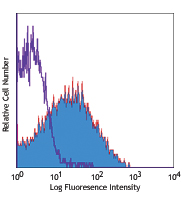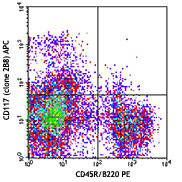- Clone
- 145-2C11; RB6-8C5; RA3-6B2; Ter-119; M1/70;
- Regulatory Status
- RUO
- Other Names
- Lin-1
- Isotype
- Armenian Hamster IgG/Rat IgG2a/Rat IgG2b
- Ave. Rating
- Submit a Review
- Product Citations
- publications

-

C57BL/6 bone marrow cells stained with FITC Lineage Cocktail and CD34 (clone RAM34) Alexa Fluor® 647 -

C57BL/6 bone marrow cells stained with FITC isotype control cocktail and CD34 (clone RAM34) Alexa Fluor® 647
| Cat # | Size | Price | Quantity Check Availability | Save | ||
|---|---|---|---|---|---|---|
| 133301 | 25 tests | 306€ | ||||
| 133302 | 100 tests | 516€ | ||||
The mouse lineage panel has been designed to react with cells from the major hematopoietic cell lineages, such as T lymphocytes, B lymphocytes, monocytes/macrophages, granulocytes, NK cells, and erythrocytes. The FITC Mouse Lineage Antibody Cocktail is designed for the flow cytometric identification of hematopoietic progenitors in mouse bone marrow. Components include anti-mouse CD3ε, clone 145-2C11; anti-mouse Ly-6G/Ly-6C, clone RB6-8C5; anti-mouse CD11b, clone M1/70; anti-mouse CD45R/B220, clone RA3-6B2; anti-mouse TER-119/Erythroid cells, clone Ter-119. FITC Mouse Lineage Isotype Control Cocktail contains equivalent concentrations of isotype-matched negative control immunoglobulin.
Materials provided:
1. FITC anti-mCD3ε/ FITC anti-mGr-1/ FITC anti-mCD11b/ FITC anti-mCD45R(B220)/ FITC anti-mTer-119, 25 tests
2. FITC Armenian hamster IgG/ FITC Rat IgG2b/ FITC Rat IgG2a isotype controls, 25 tests
Materials not provided:
Cell Staining Buffer (Cat. No. 420201)
Product Details
- Reactivity
- Mouse
- Formulation
- This two-reagent set contains FITC conjugated antibodies and isotype controls in optimal concentration for flow cytometric analysis.
- Preparation
- The antibodies are purified by affinity chromatography, and conjugated with FITC under optimal conditions.
- Storage & Handling
- The antibody solutions should be stored undiluted between 2°C and 8°C, and protected from prolonged exposure to light. Do not freeze.
- Application
-
FC - Quality tested
- Recommended Usage
-
Each lot of these antibodies is quality control tested by immunofluorescent staining with flow cytometric analysis. For flow cytometric staining, the suggested use of this reagent is 20 µl per million cells or 20 µl per 100 µl of whole blood. It is recommended that the reagent be titrated for optimal performance for each application.
- Excitation Laser
-
Blue Laser (488 nm)
- Application References
-
- Morris SJ, et al. 1997. Development. 124(10):1929-1939
- Okada S, et al. 1992. Blood180 (12):3044-3050
- Spangrude GJ, et al. 1988. Science 241 (4861):58-62
- Spangrude GJ, et al. 1990. Exp Hematol. 18 (8):920-926
- Tan SL, et al. 2006. J. Immunol. 176:2872. PubMed
- Ito R, et al. 2012. Exp Hematol. 40:953. PubMed.
- Product Citations
- RRID
-
AB_10697030 (BioLegend Cat. No. 133301)
AB_10697030 (BioLegend Cat. No. 133302)
Antigen Details
- Biology Area
- Immunology
- Gene ID
- 104231 View all products for this Gene ID
- UniProt
- View information about Lineage on UniProt.org
Related Pages & Pathways
Pages
Related FAQs
Customers Also Purchased
Compare Data Across All Formats
This data display is provided for general comparisons between formats.
Your actual data may vary due to variations in samples, target cells, instruments and their settings, staining conditions, and other factors.
If you need assistance with selecting the best format contact our expert technical support team.
 Login / Register
Login / Register 
















Follow Us